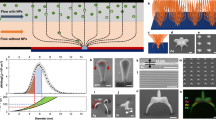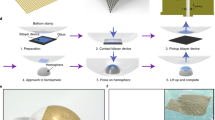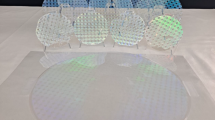Abstract
Negative-index metamaterials (NIMs) are engineered structures with optical properties that cannot be obtained in naturally occurring materials1,2,3. Recent work has demonstrated that focused ion beam4 and layer-by-layer electron-beam lithography5 can be used to pattern the necessary nanoscale features over small areas (hundreds of µm2) for metamaterials with three-dimensional layouts and interesting characteristics, including negative-index behaviour in the optical regime. A key challenge is in the fabrication of such three-dimensional NIMs with sizes and at throughputs necessary for many realistic applications (including lenses, resonators and other photonic components6,7,8). We report a simple printing approach capable of forming large-area, high-quality NIMs with three-dimensional, multilayer formats. Here, a silicon wafer with deep, nanoscale patterns of surface relief serves as a reusable stamp. Blanket deposition of alternating layers of silver and magnesium fluoride onto such a stamp represents a process for ‘inking’ it with thick, multilayer assemblies. Transfer printing this ink material onto rigid or flexible substrates completes the fabrication in a high-throughput manner. Experimental measurements and simulation results show that macroscale, three-dimensional NIMs (>75 cm2) nano-manufactured in this way exhibit a strong, negative index of refraction in the near-infrared spectral range, with excellent figures of merit.
This is a preview of subscription content, access via your institution
Access options
Subscribe to this journal
Receive 12 print issues and online access
$259.00 per year
only $21.58 per issue
Buy this article
- Purchase on Springer Link
- Instant access to full article PDF
Prices may be subject to local taxes which are calculated during checkout




Similar content being viewed by others
References
Veselago, V. G. The electrodynamics of substances with simultaneously negative values of ε and μ. Sov. Phys. Usp. 10, 509–514 (1968).
Pendry, J. B. Negative refraction makes a perfect lens. Phys. Rev. Lett. 85, 3966–3969 (2000).
Shelby, R. A., Smith, D. R. & Schultz, S. Experimental verification of a negative index of refraction. Science 292, 77–79 (2001).
Valentine, J. et al. Three-dimensional optical metamaterial with a negative refractive index. Nature 455, 376–380 (2008).
Liu, N. et al. Three-dimensional photonic metamaterials at optical frequencies. Nature Mater. 7, 31–37 (2007).
Enoch, S., Tayeb, G., Sabouroux, P., Guérin, N. & Vincent, P. A Metamaterial for directive emission. Phys. Rev. Lett. 89, 213902 (2002).
Silveirinha, M. & Engheta, N. Tunneling of electromagnetic energy through subwavelength channels and bends using ɛ-near-zero materials. Phys. Rev. Lett. 97, 157403 (2006).
Edwards, B., Alu, A., Young, M. E., Silveirinha, M. & Engheta, N. Experimental verification of ε-near-zero metamaterial coupling and energy squeezing using a microwave waveguide. Phys. Rev. Lett. 100, 033903 (2008).
Paul, O., Imhof, C., Reinhard, B., Zengerle, R. & Beigang, R. Negative index bulk metamaterial at terahertz frequencies. Opt. Express 16, 6736–6744 (2008).
Awad, M., Nagel, M. & Kurz, H. Negative-index metamaterial with polymer-embedded wire-pair structures at terahertz frequencies. Opt. Lett. 33, 2683–2685 (2008).
Dolling, G., Enkrich, C. & Wegener, M. Low-loss negative-index metamaterial at telecommunication wavelengths. Opt. Lett. 31, 1800–1802 (2006).
Alu, A. & Engheta, N. Three-dimensional nanotransmission lines at optical frequencies: a recipe for broad band negative-refraction optical metamaterials. Phys. Rev. B 75, 024304 (2007).
Dolling, G., Wegener, M. & Linden, S. Realization of a three-functional-layer negative-index photonic metamaterial. Opt. Lett. 32, 551–553 (2007).
Zhang, S. et al. Optical negative-index bulk metamaterials consisting of 2D perforated metal–dielectric stacks. Opt. Express 14, 6778–6787 (2006).
Dutta, N., Mirza, I. O., Shi, S. & Prather, D. W. Fabrication of large area fishnet optical metamaterial structures operational at near-IR wavelengths. Materials 3, 5283–5292 (2010).
Zhang, S. et al. Near-infrared double negative metamaterials. Opt. Express 13, 4922–4930 (2005).
Li, T. et al. Coupling effect of magnetic polariton in perforated metal/dielectric layered metamaterials and its influence on negative refraction transmission. Opt. Express 14, 11115–11163 (2006).
Eleftheriades, G. V. Analysis of bandwidth and loss in negative-refractive-index transmission-line (NRI–TL) media using coupled resonators. IEEE Microw. Wireless Components Lett. 17, 412–414 (2007).
Chou, S. Y., Krauss, P. R. & Renstrom, P. J. Nanoimprint lithography. J. Vac. Sci. Technol. B 14, 4129–4133 (1996).
Costner, E. A., Lin, M. W., Jen, W. L. & Willson, C. G. Nanoimprint lithography materials development for semiconductor device fabrication. Annu. Rev. Mater. Res. 39, 155–180 (2009).
Xia, Y., Rogers, J. A., Paul, K. E. & Whitesides, G. M. Unconventional methods for fabricating and patterning nanostructures. Chem. Rev. 99, 1823–1848 (1999).
Gates, B. D., Xu, Q., Love, J. C., Wolfe, D. B. & Whitesides, G. M. Unconventional nanofabrication. Annu. Rev. Mater. Res. 34, 339–372 (2004).
Lee, M. H., Huntington, M. D., Zhou, W., Yang, J. & Odom, T. W. Programmable soft lithography: solvent-assisted nanoscale embossing. Nano Lett. 11, 311–315 (2011).
Rolland, J. P., Hagberg, E. C., Carter, K. R. & DeSimone, J. M. High resolution soft lithography: enabling materials for nano-technologies. Angew. Chem. Int. Ed. 43, 5796–5799 (2004).
LaFratta, C. N., Li, L. & Fourkas, J. T. Soft-lithographic replication of 3D microstructures with closed loops. Proc. Natl Acad. Sci. USA 103, 8589–8594 (2006).
Hill, D. N., Lee, J. D., Cochran, J. K. & Chapman, A. T. Vapour deposited cone formation during fabrication of low voltage field emitter array cathods. J. Mater. Sci. 31, 1789–1796 (1996).
Lee, H., Park, Y., Kim, J., Choi, J. & Kim, J. Investigation of the formation mechanism of Spindt-type cathode by simulation and experiments. J. Vac. Sci. Technol. B 17, 547–551 (1999).
Melik, R., Unal, E., Perkgoz, N. K., Puttlitz, C. & Demir, H. V. Flexible metamaterials for wireless strain sensing. Appl. Phys. Lett. 95, 181105 (2009).
Falco, A. D., Ploschner, M. & Krauss, T. F. Flexible metamaterials at visible wavelengths. New J. Phys. 12, 113006 (2010).
Peralta, X. G. et al. Large-area metamaterials on thin membranes for multilayer and curved applications at terahertz and higher frequencies. Appl. Phys. Lett. 94, 161113 (2009).
Meitl, M. A. et al. Transfer printing by kinetic control of adhesion to an elastomeric stamp. Nature Mater. 5, 33–38 (2006).
Smith, D. R., Schultz, S., Markos, P. & Soukoulis, C. M. Determination of effective permittivity and permeability of metamaterials from reflection and transmission coefficients. Phys. Rev. B 65, 195104 (2002).
Chen, X., Grzegorczyk, T. M., Wu, B. I., Pacheco, J. Jr & Kong, J. A. Robust method to retrieve the constitutive effective parameters of metamaterials. Phys. Rev. E 70, 016608 (2004).
Smith, D. R., Vier, D. C., Koschny, T. & Soukoulis, C. M. Electromagnetic parameter retrieval from inhomogeneous metamaterials. Phys. Rev. E 71, 036617 (2005).
Johnson, P. B. & Christy, R. W. Optical constants of the noble metals. Phys. Rev. B 6, 4370–4379 (1972).
Acknowledgements
The work at University of Illinois was supported by a grant from the Office of Naval Research. The authors also gratefully knowledge the contribution of Sandia National Laboratory, which is a multi-programme laboratory operated by Sandia Corporation, a Lockheed Martin Company, for the US Department of Energy (contract no. DE-AC04-94AL85000), in fabricating the large-area master mask using deep UV lithography.
Author information
Authors and Affiliations
Contributions
D.C. conceived the idea and designed experiments. J.A.R. provided technical guidance. D.C., K.S. and T.C. performed the experiments. D.C. measured, analysed and simulated the data. G.R.B., S.G., A.M., A.C., A.B. and P.B. contributed materials and analysis tools. D.C. and J.A.R. co-wrote the paper.
Corresponding author
Ethics declarations
Competing interests
The authors declare no competing financial interests.
Supplementary information
Supplementary information
Supplementary information (PDF 970 kb)
Rights and permissions
About this article
Cite this article
Chanda, D., Shigeta, K., Gupta, S. et al. Large-area flexible 3D optical negative index metamaterial formed by nanotransfer printing. Nature Nanotech 6, 402–407 (2011). https://doi.org/10.1038/nnano.2011.82
Received:
Accepted:
Published:
Issue Date:
DOI: https://doi.org/10.1038/nnano.2011.82
This article is cited by
-
Realization of high aspect ratio metalenses by facile nanoimprint lithography using water-soluble stamps
PhotoniX (2023)
-
High-fidelity and clean nanotransfer lithography using structure-embedded and electrostatic-adhesive carriers
Microsystems & Nanoengineering (2023)
-
Birefringent response of graphene oxide film structurized via femtosecond laser
Nano Research (2022)
-
A 3D Unstructured Mesh FDTD Scheme for EM Modelling
Archives of Computational Methods in Engineering (2021)
-
Soft optical metamaterials
Nano Convergence (2020)



